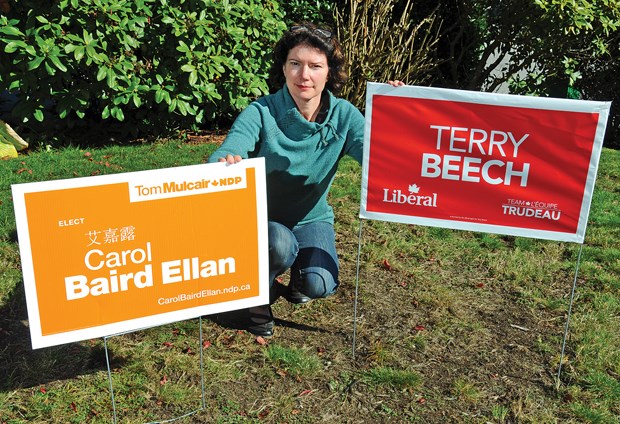Deep Cove resident Margo Smith-Kavanagh says she always votes in federal elections, but this is the first time she’s had an election sign on her lawn.
Make that two signs.
Smith-Kavanagh, who lives in the new riding of Burnaby North-Seymour, has put up signs for NDP candidate Carol Baird Ellan and Liberal candidate Terry Beech. “Some people have asked about it,” she said. “It’s prompted discussion.”
“I’m undecided,” she added. Smith-Kavanagh said she’s been impressed with both candidates and is comfortable with both Justin Trudeau and Tom Mulcair as party leaders. “I’d like my vote to count,” she said.
Smith-Kavanagh isn’t alone. Depending on which poll is consulted and when it was done, pollsters put the undecideds at anywhere from 10 to 25 per cent of voters.
That number usually narrows slightly closer to voting day, but the three-way race that’s been happening this election may keep the number of undecideds up until close to the end. So far, national polls indicate none of the parties have enough of the popular vote to put them in range of a majority government and even the question of who could form a minority is up for grabs.
That means courting of the undecideds will happen in earnest during the last weeks of the campaign.
But “undecideds” are actually a complex group of voters, say the pollsters, and strategists who study voting behaviour.
One group of undecideds is truly ambivalent and probably doesn’t care much about politics, said Greg Lyle, a pollster and political strategist with Innovative Research, who makes his home on the Sunshine Coast. “They’re not following it closely. When they say they have no opinion, they don’t have an opinion.”
They also probably don’t vote, which isn’t surprising considering voter turnout in the last federal election was only 61 per cent. “Almost half the electorate doesn’t vote,” he said. “They’re a long-term project.”
More interesting to campaign strategists are people who do vote, but who are either torn about who to vote for, or are leaning towards one choice but could be swayed to another. “They’re the real battleground,” said Lyle.
Among those are voters Lyle describes as “Time-for-a-change Tories”: people who generally agree with Conservative policies but who’ve become disenchanted with the government over issues like the Mike Duffy trial or recent stance on Syrian refugees.
Mario Canseco, whose company Insights West recently conducted riding-level polls in each of three North Shore ridings, said his polling found a lot of disaffected Conservatives out there locally, who could be wooed back by the party. More so than other partisans, “Conservative voters usually do not have a second choice,” said Canseco. “This is something the Conservatives are counting on.”
Another large group, on the other side of the political spectrum, are the “NDP/Liberal switchers” said Lyle. They tend to be left-wing, urban, more often women than men and concerned about the environment. They also tend to be those targeted by strategic voting campaigns.
Smith-Kavanagh could be considered part of both those conflicted voter groups. She’s voted mostly Conservative in the past, she said, but is now considering a strategic vote against the party, citing the cumulative effect of the Duffy scandal, robocalls, attack ads and concern over the Kinder Morgan pipeline proposal as reasons to change her vote.
There are other smaller groups of conflicted voters, said Lyle – like the economically well-off Liberal/Conservative switchers and the angry don’t-trust-politicians NDP/Conservative populist flip-floppers.
But the goal for all parties in the final weeks is the same – getting the undecideds into their camp. Two ways to do that, said Lyle, is to either “tell them bad things about the other parties” – which is why attack ads often ramp up in the final weeks of a campaign – or focus on specific issues you think will favour your own team.
Often, said Lyle, conflicted voters will end up making their choice based on which issue they’ve discussed most recently or what makes the news closest to the vote.
“The idea of people with a list of pros and cons trying to come up with a decision like a jury – that is not how people vote,” he said.



